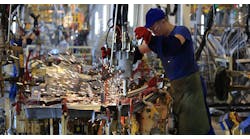Chinese Manufacturers Ask: ‘How Can Americans Still Afford to Buy from Us?’
I was recently a guest speaker at a major industrial conference in Shandong, China. There were more than 400 high-level attendees, with me being the only westerner involved or present. Organized by the regional government, it featured governmental officials who spoke briefly on the U.S. trade tensions and then moved on to regulatory issues.
A speaker from a research institute talked about emerging manufacturing technologies and how they would affect future industrial development. A speaker from a major steel producer addressed the current steel shortage and its rapidly rising price. He anticipated that by year’s end, raw ore imports will have caught up and the expectations were that prices for steel would move back down.
The major point of interest at the conference was shipping, and that was addressed by a speaker immediately prior to my closing presentation. He cited the following example. Pre-Covid-19, the cost of shipping a container from Shanghai to Los Angeles was about $1,600. Today, if you are lucky enough to get one, it could cost you up to $20,000 to ship that container. The problem is mainly due to a chronic shortage of containers. The expert predicted that by the end of the year, after the Christmas rush, it would see prices fall to around $5,000 per container for said route. He was, however, emphatic that the days of a $1,600 container will never return.
None of the information presented provided much solace to the attending industrial companies. In common with their American counterparts, all have suffered through the trade dispute between the two countries, as well as from Covid-19 related disruptions. Many larger industrial companies have attempted to provide some level of assistance to their suppliers; however, there was no government assistance or support of any kind. These problems have recently been compounded by recent regional lockdowns due to recurring COVID-19 outbreaks. The overall end-result is that China has lost about 20% of its industrial-sector companies over the last three years.
My presentation focused on the issues faced by American companies due to these same issues. It was almost a mirror image of the problems the conference’s attendees faced. In typical Chinese fashion, the 400 or so attendees sat in silence, stoically, while I spoke. However, in the Q&A that followed, I was bombarded with questions.
One issue that was dominant was “How can the Americans still afford to buy from China?” As an example of what he meant by this, a questioner said his company had an American customer for components that spent about $100,000 a month on their parts, but over the last 18 months, “they have been spending more than that on air freight.” Many others confirmed that they had seen similar situations with their U.S.-based customers.
It was a good question, and one I could only answer by explaining that in the U.S., purchasing organizations are primarily fixed on obtaining the lowest “piece-price,” pretty much regardless of other factors. When asked “why,” I responded that reduction in material was the primary metric used to judge and reward purchasing managers. I was then again asked, “why?” My response was that material variance is a primary focus when U.S. corporate CFOs report their quarterly financial results to stock analysts where, by the way, total cost is seldom—if ever—mentioned. I had to explain this several times, as most of the attendees were incredulous to the fact—since for the most part, Chinese industrial policy is based on long-term planning and results.
Chinese industrial companies use a supply chain philosophy closer to the Japanese model.
They regard their suppliers as a vital component of their manufacturing ecosystem. Most suppliers are geographically close to their customers and so are more closely integrated with them than their western counterparts. “Total cost,” not “piece-price” is what is measured.
Despite most of the attending companies having current or past business relations with American customers, most were completely unaware of how Americans viewed performance in its purchasing function. It didn’t make sense to them, but did generate a few laughs during what was otherwise a fairly gloomy conference.
During the entire conference, I heard not one negative comment about America. Not one. To be sure, the Chinese are no fans of the U.S. government, but many have enjoyed good business relationships with American customers for years. And many friendships still endure. Yet there is, and has been for some time, an acceptance by Chinese manufacturers that there is no long-term future in continuing to rely on the U.S. market as their primary customer. They have come to this conclusion reluctantly, and most have been working to expand their markets to other countries.
Professionally, and recognizing in advance the trade issues between the U.S. and China, I have been advising my American clients to explore alternatives to China sourcing. And helping them understand that if honest total cost metrics are employed, the cost benefit to sourcing in China just isn’t there anymore. I recommend Paul Ericksen’s book Better Business: Breaking Down the Walls of the Purchasing Silo if you’d like a better understanding of these financial trade-offs.
Long lead times and forecasts are little more than wishful thinking in today’s uncertain world. Onshoring to an American supply base is the future for American industry. I hope U.S. OEMs recognize this before it’s too late to address the country’s manufacturing decline.
Eamon McKinney, Ph.D., M.B.A., (sinologist) is an expert on China-related business issues in the world. He has contributed numerous articles on the subject to publications including the Financial Times, the Economist and the Far Eastern Economic Review.
McKinney will speak in the virtual portion of the IndustryWeek Manufacturing & Technology Conference. on the trade relationship between the U.S. and China and how it is changing.




